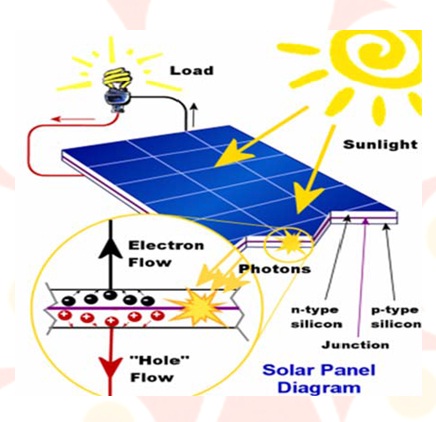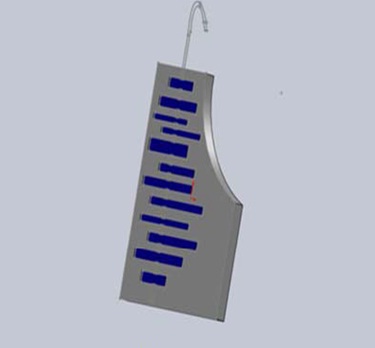Solar Mobile Charger
Published on Nov 23, 2015
Abstract
It works on the principle that when light falls on the solar cell, electron -hole pairs are created in the n-type emitter and in the p-type base.The generated electrons (from the base) and holes (from the emitter) then diffuse to the junction and are swept away by the electric field, thus producing. Certain modules are selected and worked out to suitable specifications.
The development of solar charger goes from the fundamental level like soldering lamination and making the panel etc. The developed charger is planned for 6 Volts with ma capacity at bright sunlight and step down to 5Volts using regulator.In the report, the detailed experimental characteristics of mobile charger are noted.
Solar energy is the energy produced directly by the sun and collected elsewhere, normally the Earth. The sun creates its energy through a thermonuclear process . The process creates heat and electromagnetic radiation. Only a very small fraction of the total radiation produced reaches the Earth. The radiation that does reaches the Earth is the indirect source of nearly every type of energy used today .
The radiation that does reach the Earth is the indirect source of nearly every type of energy used today. The exceptions are geothermal energy, and nuclear fission and fusion. Even fossil fuels owe their origins to the sun; they were once living plants and animals whose life was dependent upon the sun. Much of the world's required energy can be supplied directly by solar power. More still can be provided indirectly. The practicality of doing so will be examined, as well as the benefits and drawbacks. In addition, the uses solar energy is currently applied to will be noted.
Due to the nature of solar energy, two components are required to have a functional solar energy generator. These two components are a collector and a storage unit. The collector simply collects the radiation that falls on it and converts a fraction of it to other forms of energy (either electricity and heat or heat alone). The storage unit is required because of the non-constant nature of solar energy; at certain times only a very small amount of radiation will be received.
At night or during heavy cloudcover, for example, the amount of energy produced by the collector will be quite small. The storage unit can hold the excess energy produced during the periods of maximum productivity, and release it when the productivity drops. In practice, a backup power supply is usually added, too, for the situations when the amount of energy required is greater than both what is being produced and what is stored in the container
Photovoltaic Cell
The term "photovoltaic" comes from the Greek (photo) means "light", and "voltaic", means electric ,from the name of the Italian physicist “VOLTA "after whom a unit of electro-motive force, the volt is named. The sun is a star made up of hydrogen and helium gas and it radiates an enormous amount of energy every second . A photovoltaic cell is an electrical device that convert the energy of light directly into electricity by photovoltaic effect.
Photovoltaics is the field of technology and research related to the practical application of photovoltaic cells in producing electricity from light, though it is often used specifically to refer to the generation of electricity from sunlight. Cells can be described as photovoltaic even when the light source is not necessarily sunlight (lamplight, artificial light, etc.). In such cases the cell is sometimes used as a photodetector (for example infrared detectors,detecting light or other electromagnetic radiation near the visible range, or measuring light intensity.
The operation of a photovoltaic (PV) cell requires 3 basic attributes: The absorption of light, generating either electron-hole pairs or excitons. The separation of charge carriers of opposite types. The separate extraction of those carriers to an external circuit. In contrast, a solar thermal collector collects heat by absorbing sunlight, for the purpose of either direct heating or indirect electrical power generation.
"Photoelectrolytic cell" (photoelectrochemical cell), on the other hand, refers either a type of photovoltaic cell (like that developed by A.E. Becquerel and modern dye-sensitized solar cells or a device that splits water directly into hydrogen and oxygen using only solar illumination. Photovoltaic power generation employs solar panels composed of a number of solar cells containing a photovoltaic material. Materials presently used for photovoltaics include monocrystalline silicon, polycrystalline silicon, amorphous silicon, cadmium telluride, andcopper indium gallium selenide/sulfide.
Due to the increased demand for renewable energy sources, the manufacturing of solar cells and photovoltaic arrays has advanced considerably in recent years. Solar photovoltaics is a sustainable energy source. By the end of 2011, a total of 71.1 GW had been installed, sufficient to generate 85 TWh/year.And by end of 2012, the 100 GW installed capacity milestone was achieved. Solar photovoltaics is now, after hydro and wind power, the third most important renewable energy source in terms of globally installed capacity. More than 100 countries use solar PV. Installations may be ground-mounted (and sometimes integrated with farming and grazing) or built into the roof or walls of a building (either building-integrated photovoltaics or simply rooftop).
Driven by advances in technology and increases in manufacturing scale and sophistication, the cost of photovoltaics has declined steadily since the first solar cells were manufactured, and the levelised cost of electricity (LCOE) from PV is competitive with conventional electricity sources in an expanding list of geographic regions. Net metering and financial incentives, such as preferential feed-in tariffs for solar-generated electricity, have supported solar PV installations in many countries.With current technology, photovoltaics recoup the energy needed to manufacture them in 3 to 4 years. Anticipated technology would reduce time needed to recoup the energy to 1 to 2 year.
Solar Mobile Charger Unit

• Portable Solar Mobile Charger for mobile phone can be charged with Sun light and electrical power. It stores power from the sun and charge mobile phone,iPod,etc.
• Solar cell phone chargers use solar panels to charge cell phone batteries. They are an alternative to conventional electrical cell phone chargers and in some cases can be plugged into an electrical outlet.
• There are also public solar chargers for mobile phones which can be installed permanently in public places such as streets, park and squares.
• The model which is according to European Commission proclaimed as the first in the world is the Strawberry Tree, public solar charger invented by Strawberry energy Company. This solar station won the first place at "EU Sustainable energy week (EUSEW) 2011" in the Consuming category.
• Some models of cell phones have a built in solar charger and are commercially available for GSM cellphone models.
• Solar cell phone chargers come in different shapes and configurations including folding and rotating types.
Specifications of Charger
• Uses high-efficiency monocrystalline silicon
• Solar panel: 5.5V/1000mA
• Output voltage: 5.5V
• Output current: 300-550mA
Design of Charger
• A multicrystallinesolar cell is taken and its cut into 12 parts.
• By taking tabbing wire and applying flux, paste is done .
• This is done from top of one cell to bottom of the other cell. They are connected in series. The above process is continued for remaining cells.
• A wire comes from positive side of cell and another wire comes from the negative side.
• The whole arrangement is then placed on top of an acrylic sheet,teflon.
• On top these panels EVA is placed and are attached with feviquick
• These wires are connected to the terminals of a regulator.
• Using multimeter we verify the voltage is brought down to 5 V.
• Regular terminals are further connected to multipincable.
The pin is then connected to mobile to charge it

Conclusion and Future Scope
• To make sure we have plenty of energy in the future, it's up to all of us to use energy wisely.
• We must all conserve energy and use it efficiently. It's also up to those who will create the new energy technologies of the future.
• All energy sources have an impact on the environment. Concerns about the greenhouse effect and global warming, air pollution, and energy security have led to increasing interest and more development in renewable energy sources such as solar, wind, geothermal, wave power and hydrogen
• In solar mobile charger ripples will not be there as we use DC power directly to charge the mobile.
• Battery life is more as high voltages are not developed.
• Versatility of Solar mobile charger is high.
• Life of the battery will be high as we use solar mobile charger.
• Adaptability is high.
References
solarsemiconductor industry visit
http://en.wikipedia.org/wiki/solar_cell
encyclobeamia.solarbotics.net/article.
www.solarbuzz.com/going-solar `
www.solarserver.com/knowledge